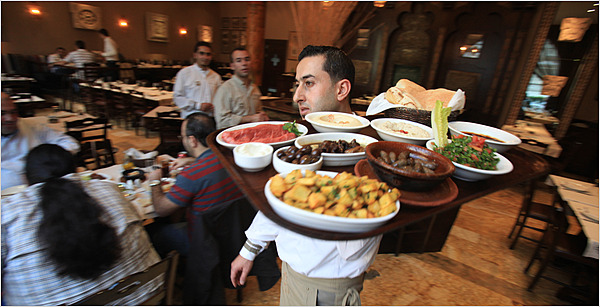This week's Travel Tuesday feature is brought to you by a guest blogger from Beirut, Lebanon.
Sub the well-trampled Eiffel Tower for the Ottoman Clock Tower at the Grand Sérail. Instead of walking through the Arc de Triomphe, swim through the arched Pigeons' Rocks at Raouché. Rather than the glass pyramid at the Louvre, see the Egyptian Revival building at the National Museum of Beirut, the Paris of the East. After all, that's what it means to be
"relatively offbeat."
Beirut,
Lebanon's capital and largest city, has something for everyone. If you
want to rub elbows with a real-life Middle Eastern prince, there's a
night club or two for you, and other popular soirees are located right
on the warm, sandy beaches. For the history buffs, Beirut is packed with
archaeological treasures reaching back the dawn of history. After
dancing all night, swimming all morning, and museum-hopping all
afternoon, refuel on top cuisine at one of Beirut's world-renowned restaurants, with menus ranging from traditional Lebanese to Asian fusion.
 Nightlife
Nightlife
Beirut's ultimate night club must be SkyBar. This rooftop venue was voted "coolest night club in the world" by The New York Times,
and it consistently appears on DJmag's Top 100 Clubs list. It is
positioned between the white-capped mountains on one side and the
white-capped waves on the other, and it literally hovers above the earth
while humbly meeting the sky. This point of intersection is what
inspired Lebanese architect Sari el-Khazen to design SkyBar with the
four elements - fire, water, earth, wind - in mind. The result has been
famously called something that "must be lived and felt," and the most
chic national and international VIPs unanimously agree. Other notable
rooftop night clubs include Cherry on the Rooftop and Bar ThreeSixty
(both in the Le Gray Hotel) and White, located on Sea Side Road.
There
are dozens of unique clubs in Beirut, each with its own tempo and
flair, but two of the most noteworthy are Buddha Bar and B018. Buddha
Bar, like its Parisian sister, is themed with plush elements of the Far
East, like a 30-foot tall statue of the Buddha at the end of a grand
staircase laced with golden chandeliers. It is housed in an old theater
on Riad Solh Square, but instead of seeing films, you might meet film
stars, or even royalty. A truly Lebanese club, B018 is as famous with
celebrities as it is locally for its liberal atmosphere and "wartime
architecture," which has placed it multiple times among Wallpaper's
ranks of "best bars in the world." The former Palestinian refugee camp
turned Civil War underground music venue, B018 has a hypogeal feel with
casket-shaped benches, but any morbid association is quickly lost when
the roof of the underground chamber opens up to reveal the glittering
stars of night shining down on the dance floor.
Beaches
Located
on the sapphire shores of the Mediterranean, Beirut boasts inviting
beaches aplenty, dotted with hopping night clubs in the guise of
cabanas. While much of the coastline is privately owned by various
resorts (Riviera, Praia, e.g.), some host quieter beaches (Iris, Lazy B,
e.g.), where you can relax without feeling the bass thumping in your
sternum. Resort beaches are available for non-residents with a day-pass
at a modest fee. If you prefer to avoid doling out dough, don't miss a
stroll along the Corniche, Beirut's boardwalk, where local men pole fish
and smoke shisha,
while further along, families gather for a swim, a picnic, or a dive
from the rocks into the warm, crystalline water. When you need some
refreshment after a day of sun, sand, and sea, there are plenty of
restaurants to choose from, or take advantage of the mobile coffee and
food vendors - while holding on to your coveted spot on the beach.
 Archaeology
Archaeology
Those
inspired by Indiana Jones - or real archaeologists like Kathleen Kenyon
and Howard Carter - will not want for ancient treasures in Beirut. The
city itself is a 5,000-year old harbor, and prehistoric finds highlight
the profound complexities of Paleolithic humankind. Roman baths are
being restored right in the city's Downtown Central District, and the
American University of Beirut campus is also home to the National Museum
of Beirut, which houses a vast array of invaluable artifacts:
prehistoric, Canaanite, Phoenician, Egyptian, Greek, Roman, Byzantine,
Arab, and Ottoman.
Although
the museum is already brimming with fascinating finds, more is surely
to come. As Beirut experiences a building boom, a team of very devoted
local archaeologists is doing everything it can to record structures and
resurface artifacts before new condos and office buildings are planted
on top of them. Their efforts are bound to bring even more of Beirut's
most distant and more recent past into the limelight it deserves.

Restaurants
The
culture of food is gaining attention from anthropologists and tourists
alike. Beirut is one of those destinations that offers visitors insight
into traditional recipes for houmous, baba ghanoush, and kebab, as well
as tastes of the foreign and modern, like sculpted seafood, or for
dessert, a feuillantine aux framboises that you might swear was created in a Parisian patisserie.
Lebanese cuisine outside of Lebanon is rarely as delicious and economical as it is in its homeland, even in the bustling and chic Downtown Beirut.
Do not miss the opportunity to gorge yourself on mezze, and reviewers
agree that Karam is a great place to start. This world-famous restaurant
is located near Nejmeh Square (Place de l'Etoile), and it offers
authentic Lebanese cuisine, friendly service, and a lovely setting, all
for a very reasonable price.
If
you're so lucky to stay in Lebanon long enough to start missing your
native cuisine, try Le Relais de l’Entrecôte for steak with a
world-famous secret sauce and exquisite desserts, or Bob's Easy Diner
for a 50s jukebox feel and a philly, cheese burger, or barbeque. Would
you like French fries with that? Yes, with houmous, please.
Image Credits:
nytimes.com
downtownbeirut.com
















































